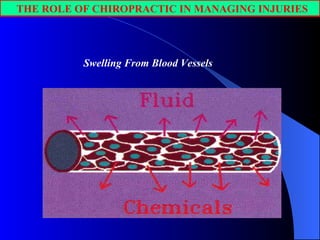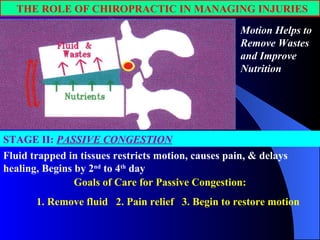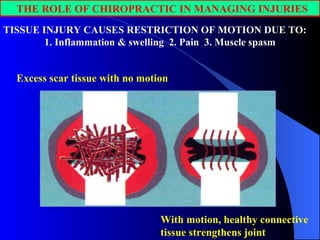Chiropractic And Injury
- 1. THE ROLE OF CHIROPRACTIC IN MANAGING INJURIES Swelling From Blood Vessels
- 2. THE ROLE OF CHIROPRACTIC IN MANAGING INJURIES STAGES OF TISSUE HEALING â STAGE I: ACTIVE SWELLING 1.Swelling occurs for 12 to 72 hours / 2.Motion is lost and pain increases Goals of Care: Minimize pain, swelling Care: 1.Rest & support of injured area / 2.Ice to block swelling, pain, and spasm Muscle Spasm Restricts Motion
- 3. THE ROLE OF CHIROPRACTIC IN MANAGING INJURIES STAGE II: PASSIVE CONGESTION Fluid trapped in tissues restricts motion, causes pain, & delays healing, Begins by 2 nd to 4 th day Goals of Care for Passive Congestion: 1. Remove fluid 2. Pain relief 3. Begin to restore motion Motion Helps to Remove Wastes and Improve Nutrition
- 4. THE ROLE OF CHIROPRACTIC IN MANAGING INJURIES Care: Chiropractic Adjustments help a. restore motion b. block pain c. restore normal sensation d. relax tight muscles c. remove swelling e. accelerate healing Heat and cold to remove fluid Controlled Motion Exercises Physical therapy help in some cases
- 5. THE ROLE OF CHIROPRACTIC IN MANAGING INJURIES TISSUE INJURY CAUSES RESTRICTION OF MOTION DUE TO: 1. Inflammation & swelling 2. Pain 3. Muscle spasm Excess scar tissue with no motion With motion, healthy connective tissue strengthens joint
- 6. THE ROLE OF CHIROPRACTIC IN MANAGING INJURIES The Major Goals Of Chiropractic Care: Relieve pain 2. Promote full healing 3. Restore & maintain full function 4. Reduce the likelihood of reinjury 5. Prevent accelerated degeneration
- 7. THE ROLE OF CHIROPRACTIC IN MANAGING INJURIES Chiropractic Care should continue throughout the repair stage. It takes longer for tissues to heal & normal function to be restored than it takes for pain relief. Pain relief is not the only goal, Chiropractic helps: 1. Restore normal motion, function & biomechanics 2. Improve alignment of new connective tissue 3. Prevent shortening of scar tissue & chronic stiffness 4. Restore & maintain flexibility of ligaments and muscles 5. Restore normal muscle toe & coordination 6. Promote quicker, more effective healing 7. Restore & maintain normal sensation 8. Reduce the risk of reinjury and degeneration
- 8. THE ROLE OF CHIROPRACTIC IN MANAGING INJURIES
- 9. THE ROLE OF CHIROPRACTIC IN MANAGING INJURIES Excess scar tissue with no motion With motion, healthy connective tissue strengthens joint
- 10. THE ROLE OF CHIROPRACTIC IN MANAGING INJURIES Beginning 5 days after injury, scar tissue is made for up to 6 weeks . Lack of motion causes excess scar tissue in dense patterns disrupting normal function causing: Excess scarring 6. Weak muscles & ligaments Chronic stiffness 7. Loss of normal sensation Limited range of motion 8. Poor nutrition Poor biomechanics 9. Increased risk of reinjury Chronic pain 10. Accelerated degeneration STAGE III: REPAIR
- 11. THE ROLE OF CHIROPRACTIC IN MANAGING INJURIES If motion is restored & maintained, tissues heal in a much more functional way Chiropractic Relaxes, muscles Restores normal position and movement
- 12. THE ROLE OF CHIROPRACTIC IN MANAGING INJURIES GOALS OF REPAIR STAGE: RESTORE NORMAL MOTION, SENSATION, PROMOTE FULL HEALING, RELIEVE PAIN.
- 13. THE ROLE OF CHIROPRACTIC IN MANAGING INJURIES Connective tissue remodels for better strength & flexibility. This often takes 3 to 14 weeks but may take up to 1 year with severe injury. Chiropractic helps to achieve these goals: Improve and maintain motion and flexibility Restore & maintain function Reduce chronic pain Reduce risk of reinjury & degeneration STAGE IV: REMODELING













